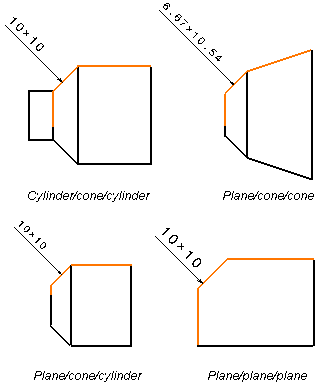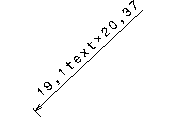This task deals with:
Creating chamfer dimensions manually |
|
-
Go to Tools > Options > Mechanical Design > Drafting > Dimensions tab and make sure the Detect chamfer check box is not selected.
-
Click Chamfer Dimensions
 in the Dimensioning toolbar (Dimensions
sub-toolbar).
in the Dimensioning toolbar (Dimensions
sub-toolbar).

-
In the Tools Palette which is displayed, you can choose:
-
The format of the dimension:
-
Length x Length (19,1 x 19,1 in our example)
-
Length x Angle (19.1 x - 46deg84'8" in our example)
-
Angle x Length (- 46deg84'8" x 19.1 in our example)
-
Length (19,1)
-
-
The representation mode:
-
One symbol

-
Two symbols

-


You can also access these options using the contextual menu: at any time during the chamfer dimension creation, you can right-click to display the contextual menu. -
-
Choose the Length x Length format and the One symbol mode
 .
. -
Select the element to be dimensioned.
-
Select a reference line or surface.
-
You have two options:
- Click on the sheet to end the dimension creation. The chamfer
dimension is computed with an implicit second reference line that
is perpendicular to the first one.
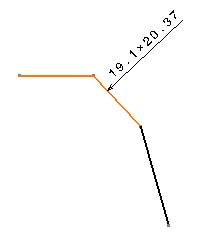
- Select a second reference line or surface. In this case, the
chamfer dimension is computed according to both reference lines you
selected.

In a Generative Drafting context (i.e. in the case of a generative view), you must do this, i.e. you must explicitly select the second reference line.
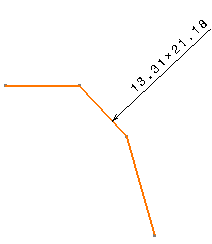
In any case, the dimension is associated to all the elements you selected.
- Click on the sheet to end the dimension creation. The chamfer
dimension is computed with an implicit second reference line that
is perpendicular to the first one.
Creating chamfer dimensions using chamfer detection |
|
-
Go to Tools > Options > Mechanical Design > Drafting > Dimensions tab and make sure the Detect chamfer check box is selected.
-
Click Chamfer Dimensions
 in the Dimensioning toolbar (Dimensions
sub-toolbar).
in the Dimensioning toolbar (Dimensions
sub-toolbar). -
In the Tools Palette which is displayed (as well as in the contextual menu), you can choose the format of the dimension and the representation mode. For more information, refer to step 3 in Creating chamfer dimensions manually.
Choose the Length x Length format and the One symbol mode .
. -
Fly the mouse over the element to be dimensioned. You can notice that, depending on where you position the cursor, the auto-detection agent indicates a different order for taking elements into account when creating the chamfer dimension:
-
1 indicates the element to be dimensioned.
-
2 indicates the line which will be used as the first reference.
-
3 indicates the line which will be used as the second reference.
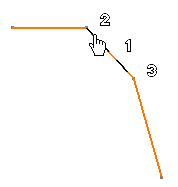
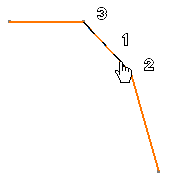
-
-
Click when you are satisfied with the order offered by the auto-detection agent. For example, click to accept the 3 - 1 - 2 order. The chamfer dimension is computed according to the first and the second auto-detected reference lines.

At this stage, if you are not satisfied with the order you just accepted, or if your chamfer is not detected, you can still click to select the first reference line, and, optionally, the second reference line. This amounts to creating the chamfer dimension manually. -
Click to end the chamfer dimension creation.
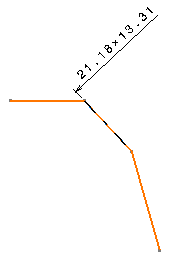
The dimension is associated to all auto-detected elements.
Remarks about chamfer dimensions |
|
- In a Generative Drafting context, you can create chamfer dimensions for the following types of cylindrical shapes: cylinder/cone/cylinder, plane/cone/cone, plane/cone/cylinder, plane/plane/plane.
- When creating chamfer dimension on cylindrical shapes in a Generative
Drafting context, remember that:
- in the case of projection views, the projection plane needs to be parallel to the cylinder axis.
- in the case of section views or section cuts, the section plane needs to to be parallel to, and to go through, the cylinder axis.
- the sketched profile on which the cylinder (or the cone) is based must be a circle.
- All settings defined in Tools > Option > Mechanical Design > Drafting (Dimensions and Manipulators tabs) are taken into account when creating chamfer dimensions.
- When editing chamfer dimension text properties (Edit >
Properties command, Dimension Texts tab), any
information (e.g. associated text, fake dimension, tolerance, text
before/after, etc.) added to the main value, will actually be positioned
according to the first value (excluding the "x" symbol, e.g. "19,1").
This information will be positioned in the following order: Text Before/Prefix/first value/Tolerance/Suffix/Text After/second value (including the "x" symbol, e.g. "x 20,37"). An example is provided below, with a Text After.
- When re-routing chamfer dimensions which have only two reference elements (the element to be dimensioned and a single reference line or surface), you will need to select three reference elements.
![]()
